Numerical Analysis of Axial Cyclic Behavior of FRP Retrofitted CHS Joints
Abstract
:1. Introduction
2. Structural Model
3. Finite Element Model and Verification
4. Investigating the Welding Process
5. Results of Cyclic Axial Loading
5.1. Non-Retrofitted Joints
5.2. Retrofitted Joints
6. Concluding Remarks
- Use of composite FPR patch for retrofitting the CHS T-joints can suspend the plastic failure and the chord ovalization buckling modes.
- Welding can decrease critical buckling load, but it can be more influential for plastic failure load.
- Welding process can lead to more local deformation on the chord surface.
- For accurate investigation of performance of CHS T-joint, it is necessary to consider the effects of the welding process, such as residual stresses and deformations.
- In the cyclic performance, both brace and chord must be retrofitted; by retrofitting just one of them, it can be possible that poor performance, especially in tension, is obtained.
- The governing buckling mode in compression load is mostly the chord ovalization.
- By comparing the chord ovalization and the brace overall buckling, it can be concluded that the brace overall buckling has better performance in terms of flexibility, energy dissipation, and load bearing capacity. Hence, it can be possible to use composite materials to propel the governing buckling mode to the brace overall buckling mode.
- Increase of the β factor in CHS T-joints increases the load bearing capacity in both tension and compression.
Author Contributions
Funding
Data Availability Statement
Conflicts of Interest
References
- Tavakkolizadeh, M.; Saadatmanesh, H. Fatigue strength of steel girders strengthened with carbon fiber reinforced polymer patch. J. Struct. Eng. 2003, 129, 186–196. [Google Scholar] [CrossRef] [Green Version]
- Rashidi, M. Finite element modeling of FRP wrapped high strength concrete reinforced with axial and helical reinforcement. Int. J. Emerg. Technol. Adv. Eng. 2014, 4, 728–735. [Google Scholar]
- Rashidi, M.; Hadi, M.N. Modelling of high strength concrete reinforced columns wrapped with FRP. In Proceedings of the 5th Civil Engineering Conference in the Asian Region and Australasian Structural Engineering Conference; The Engineers Australia, Sydney, Australia, 8–12 August 2010. [Google Scholar]
- Wang, Z.-Y.; Wang, Q.-Y.; Liu, Y.-J. Evaluation of Fatigue Strength Improvement by CFRP Laminates and Shot Peening on to the Tension Flanges Joining Corrugated Steel Webs. Materials 2015, 8, 5348–5362. [Google Scholar] [CrossRef] [Green Version]
- Lau, D.; Qiu, Q.; Zhou, A.; Chow, C.L. Long term performance and fire safety aspect of FRP composites used in building structures. Constr. Build. Mater. 2016, 126, 573–585. [Google Scholar] [CrossRef]
- Yao, M.; Zhu, D.; Yao, Y.; Zhang, H.; Mobasher, B. Experimental study on basalt FRP/steel single-lap joints under different loading rates and temperatures. Compos. Struct. 2016, 145, 68–79. [Google Scholar] [CrossRef]
- Batuwitage, C.; Fawzia, S.; Thambiratnam, D.; Al-Mahaidi, R. Durability of CFRP strengthened steel plate double-strap joints in accelerated corrosion environments. Compos. Struct. 2017, 160, 1287–1298. [Google Scholar] [CrossRef]
- Kaeseberg, S.; Messerer, D.; Holschemacher, K. Experimental study on concrete under combined FRP–Steel confinement. Materials 2020, 13, 4467. [Google Scholar] [CrossRef]
- Shaat, A.; Schnerch, D.; Fam, A.; Rizkalla, S. Retrofit of steel structures using fiber-reinforced polymers (FRP): State-of-the-art. In Proceedings of the Transportation research board (TRB) annual meeting, Washington, DC, USA, 11–15 January 2004. [Google Scholar]
- Rashidi, M.; Zhang, C.; Ghodrat, M.; Kempton, S.; Samali, B.; Akbarnezhad, A.; Zhu, L. Bridge Abutment Movement and Approach Settlement—A Case Study and Scenario Analysis. Int. J. Struct. Stab. Dyn. 2018, 18, 1840011. [Google Scholar] [CrossRef]
- Rashidi, M.; Ghodrat, M.; Samali, B.; Kendall, B.; Zhang, C. Remedial modelling of steel bridges through application of analytical hierarchy process (AHP). Appl. Sci. 2017, 7, 168. [Google Scholar] [CrossRef] [Green Version]
- Rashidi, M.; Samali, B.; Sharafi, P. A new model for bridge management: Part B: decision support system for remediation planning. Aust. J. Civ. Eng. 2016, 14, 46–53. [Google Scholar] [CrossRef] [Green Version]
- Pnevmatikos, N.G.; Papagiannopoulos, G.A.; Papavasileiou, G.S. Fragility curves for mixed concrete/steel frames subjected to seismic excitation. Soil Dyn. Earthq. Eng. 2019, 116, 709–713. [Google Scholar] [CrossRef]
- Pnevmatikos, N.G. New strategy for controlling structures collapse against earthquakes. Nat. Sci. 2012, 4, 667. [Google Scholar] [CrossRef] [Green Version]
- Cascardi, A.; Dell’Anna, R.; Micelli, F.; Lionetto, F.; Aiello, M.A.; Maffezzoli, A. Reversible techniques for FRP-confinement of masonry columns. Constr. Build. Mater. 2019, 225, 415–428. [Google Scholar] [CrossRef]
- Wang, W.; Chen, Y.-Y. Hysteretic behaviour of tubular joints under cyclic loading. J. Constr. Steel Res. 2007, 63, 1384–1395. [Google Scholar] [CrossRef]
- American Petroleum Institute, Production Department. API Recommended Practice for Planning, Designing, and Constructing Fixed Offshore Platforms; American Petroleum Institute, Production Department: Washington, DC, USA, 1977. [Google Scholar]
- Eurocode, C. 3: Design of Steel Structures, Part 1-1; “General Rules and Rules for Buildings”; John Wiley & Sons: Hoboken, NJ, USA, 2005. [Google Scholar]
- Wang, W.; Chen, Y. Modelling and classification of tubular joint rigidity and its effect on the global response of CHS lattice girders. Struct. Eng. Mech. 2005, 21, 677–698. [Google Scholar] [CrossRef]
- Chen, G.M.; Teng, J.G.; Chen, J.F.; Xiao, Q.G. Finite element modeling of debonding failures in FRP-strengthened RC beams: A dynamic approach. Comput. Struct. 2015, 158, 167–183. [Google Scholar] [CrossRef] [Green Version]
- Lesani, M.; Bahaari, M.R.; Shokrieh, M.M. Experimental investigation of FRP-strengthened tubular T-joints under axial compressive loads. Constr. Build. Mater. 2014, 53, 243–252. [Google Scholar] [CrossRef]
- Ombres, L.; Verre, S. Experimental and Numerical Investigation on the Steel Reinforced Grout (SRG) Composite-to-Concrete Bond. J. Compos. Sci. 2020, 4, 182. [Google Scholar] [CrossRef]
- Mashiri, F.R.; Zhao, X.-L. Square hollow section (SHS) T-joints with concrete-filled chords subjected to in-plane fatigue loading in the brace. Thin Walled Struct. 2010, 48, 150–158. [Google Scholar] [CrossRef]
- Yin, Y.; Han, Q.H.; Bai, L.J.; Yang, H.D.; Wang, S.P. Experimental study on hysteretic behaviour of tubular N-joints. J. Constr. Steel Res. 2009, 65, 326–334. [Google Scholar] [CrossRef]
- Lesani, M.; Bahaari, M.R.; Shokrieh, M.M. Detail investigation on un-stiffened T/Y tubular joints behavior under axial compressive loads. J. Constr. Steel Res. 2013, 80, 91–99. [Google Scholar] [CrossRef]
- SAC Joint Venture. Protocol for Fabrication, Inspection, Testing, and Documentation of Beam-Column Connection Tests and Other Experimental Specimens; Rep. No. SAC/BD-97; SAC Joint Venture: Redwood City, CA, USA, 1997; Volume 2. [Google Scholar]
- Zhao, J.; Mei, K.; Wu, J. Long-term mechanical properties of FRP tendon–anchor systems—A review. Constr. Build. Mater. 2020, 230, 117017. [Google Scholar] [CrossRef]
- Lesani, M.; Bahaari, M.R.; Shokrieh, M.M. Numerical investigation of FRP-strengthened tubular T-joints under axial compressive loads. Compos. Struct. 2013, 100, 71–78. [Google Scholar] [CrossRef]

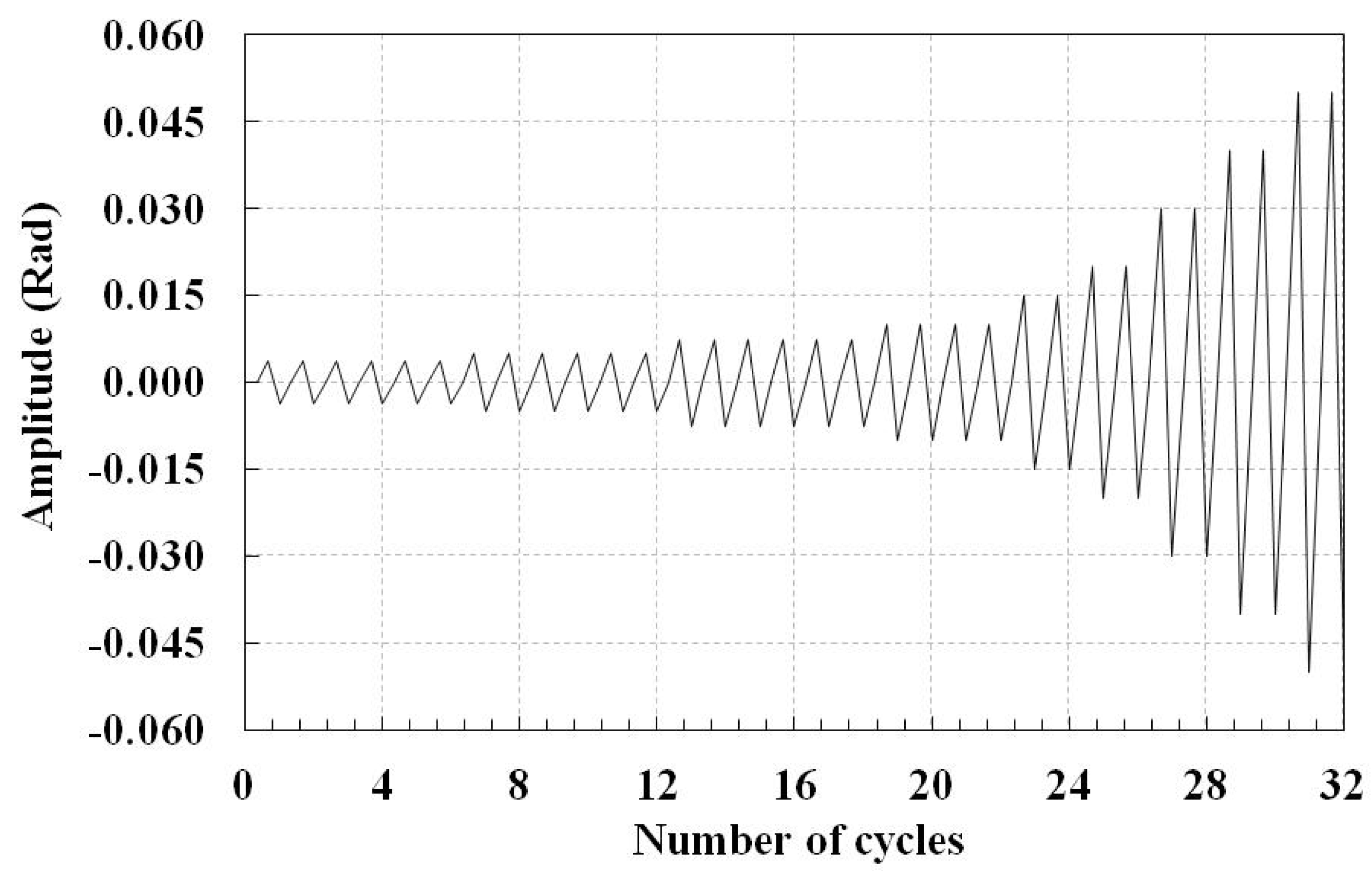
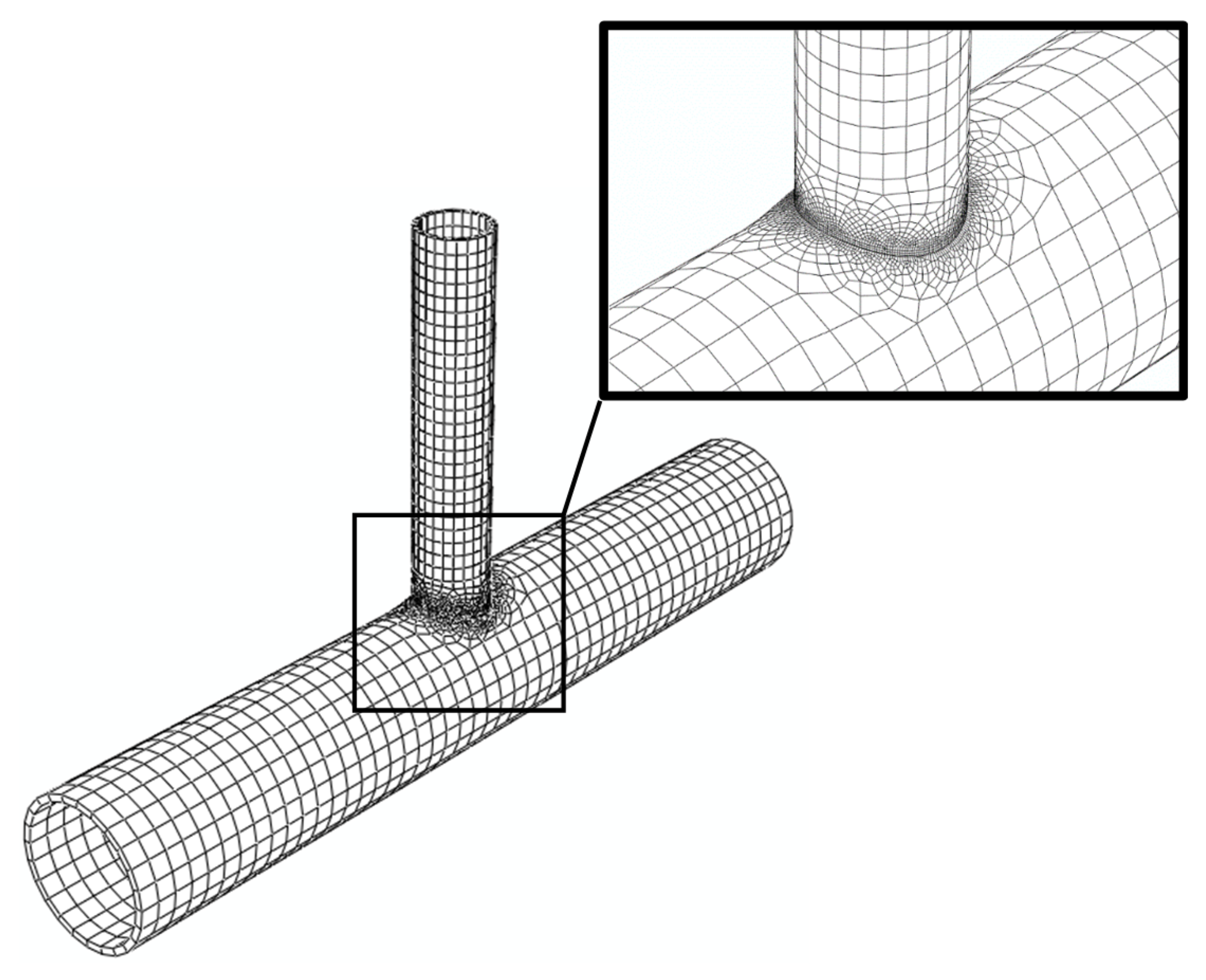

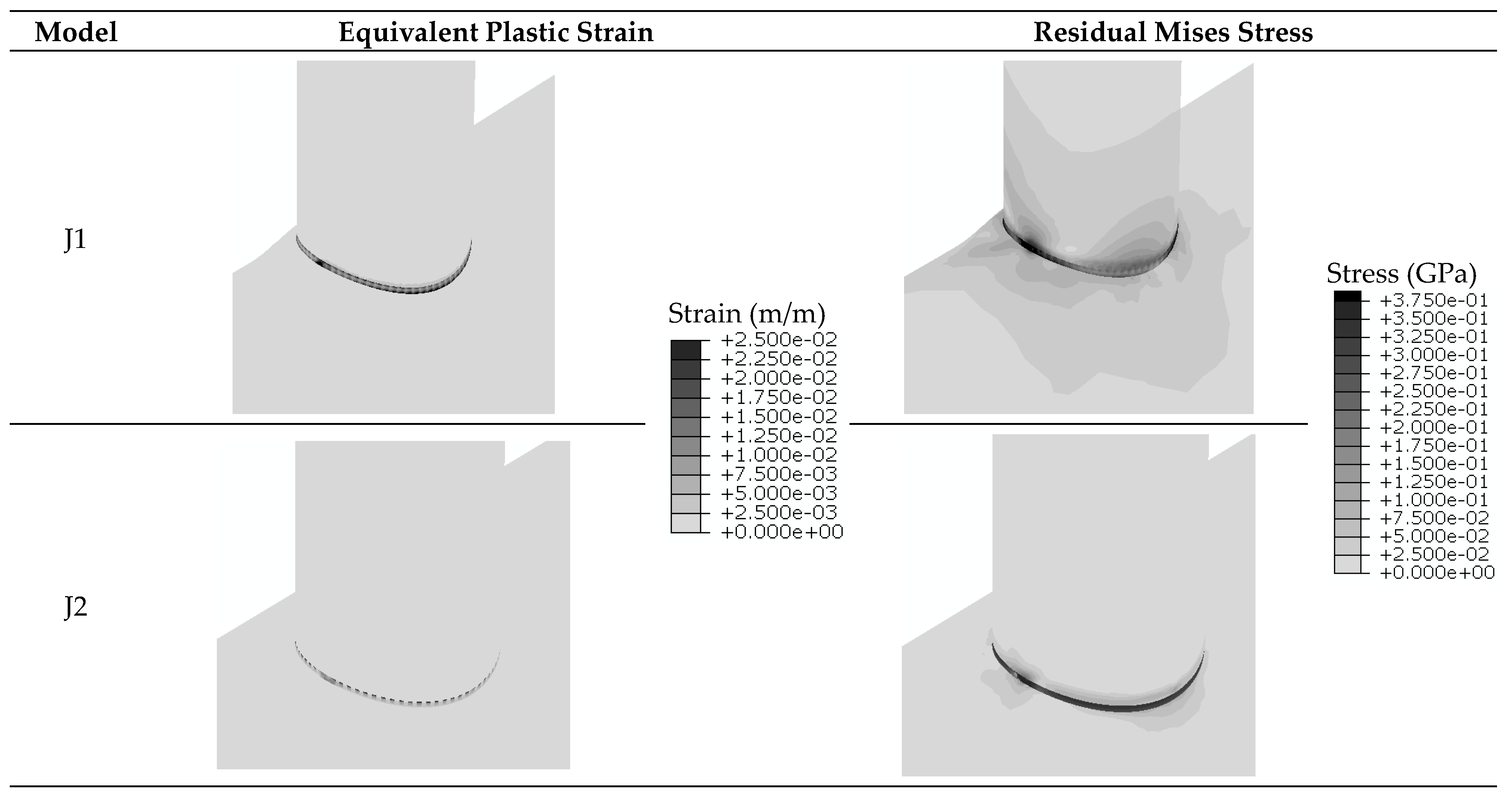

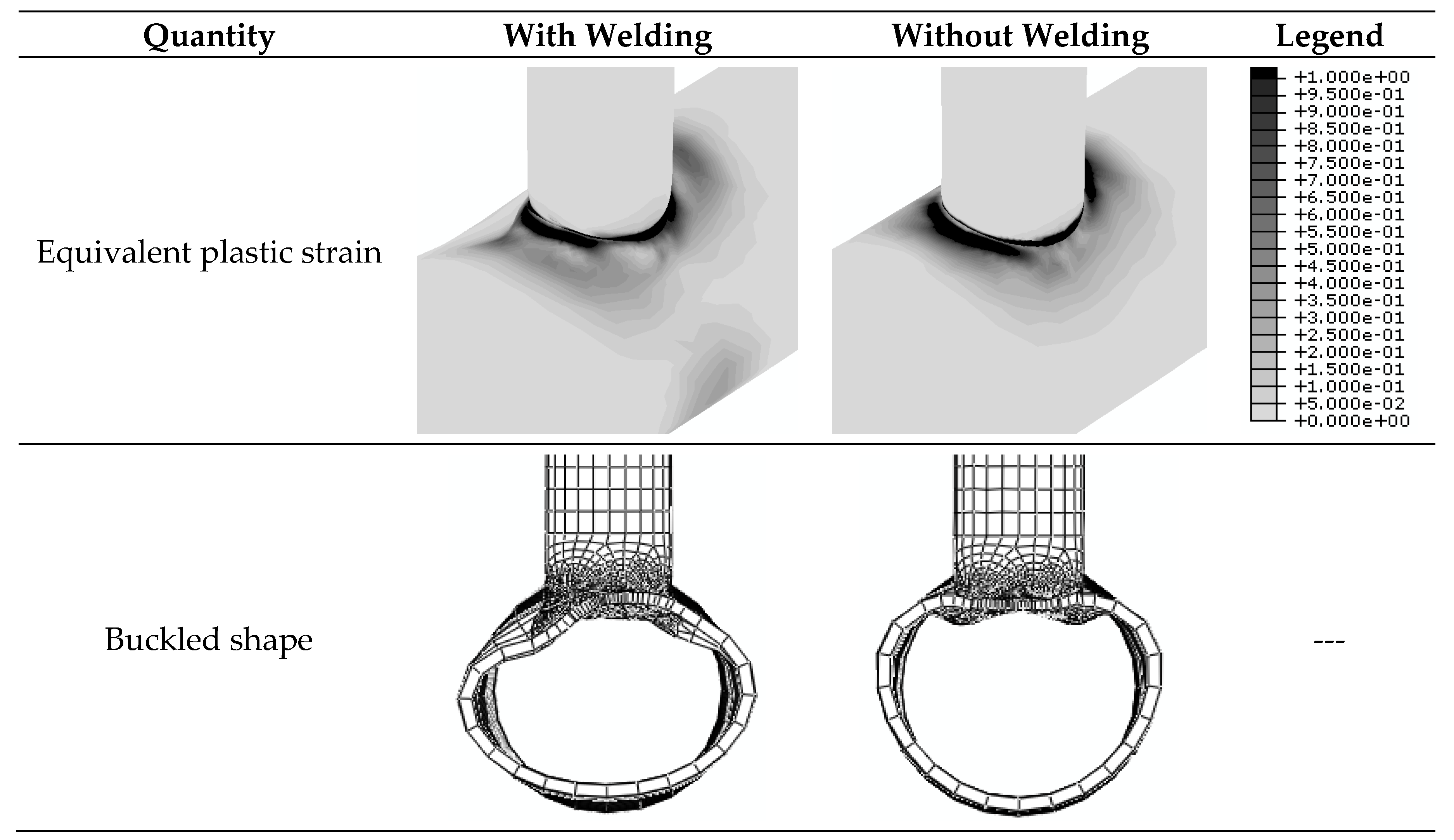
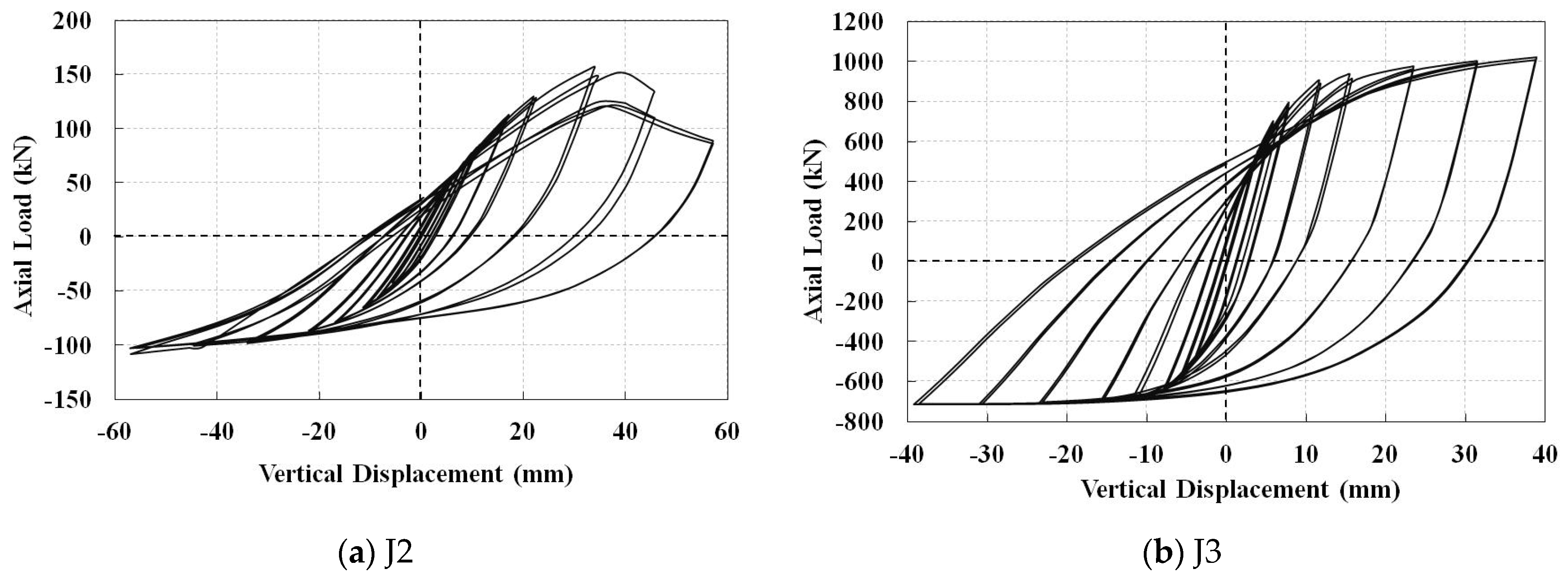
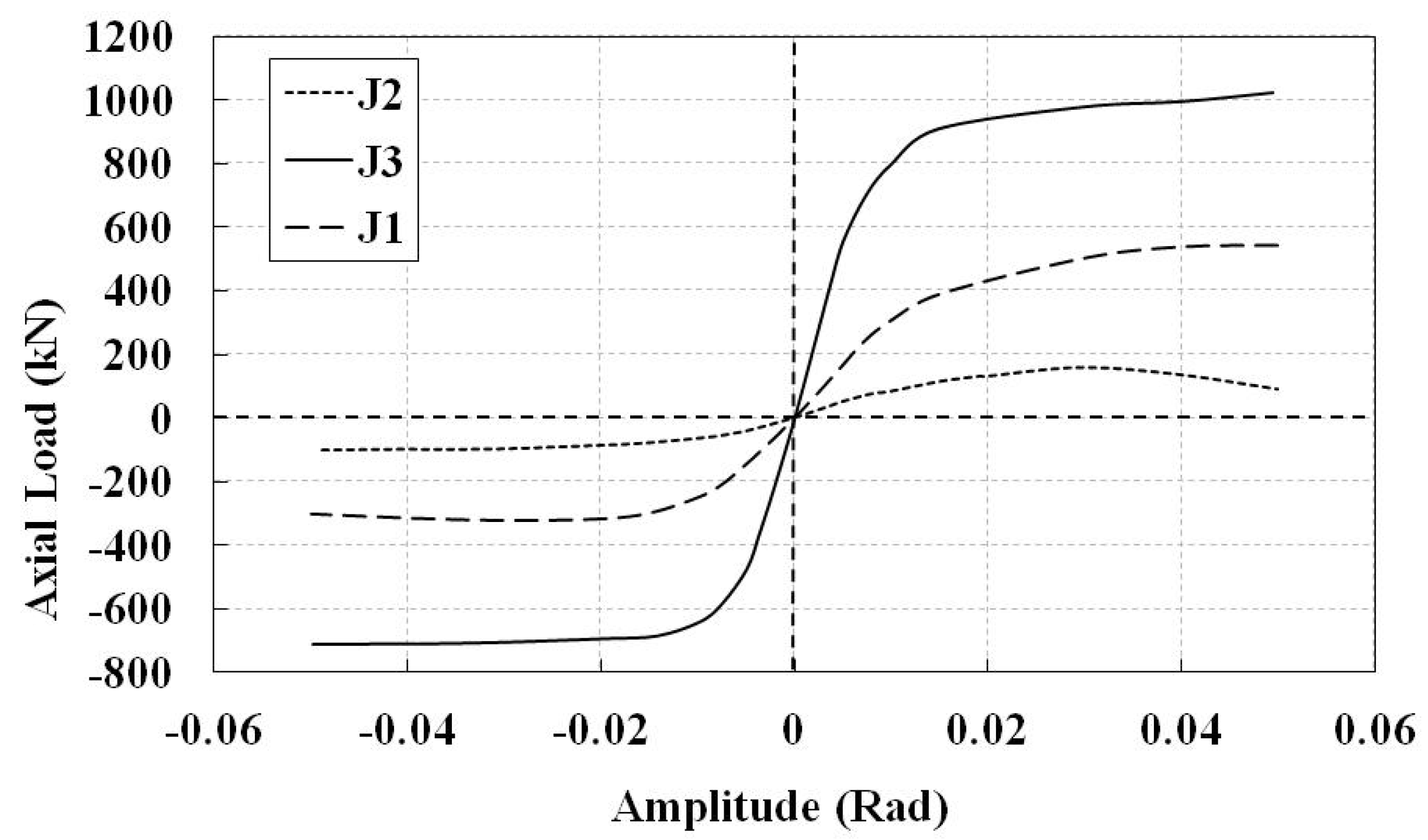

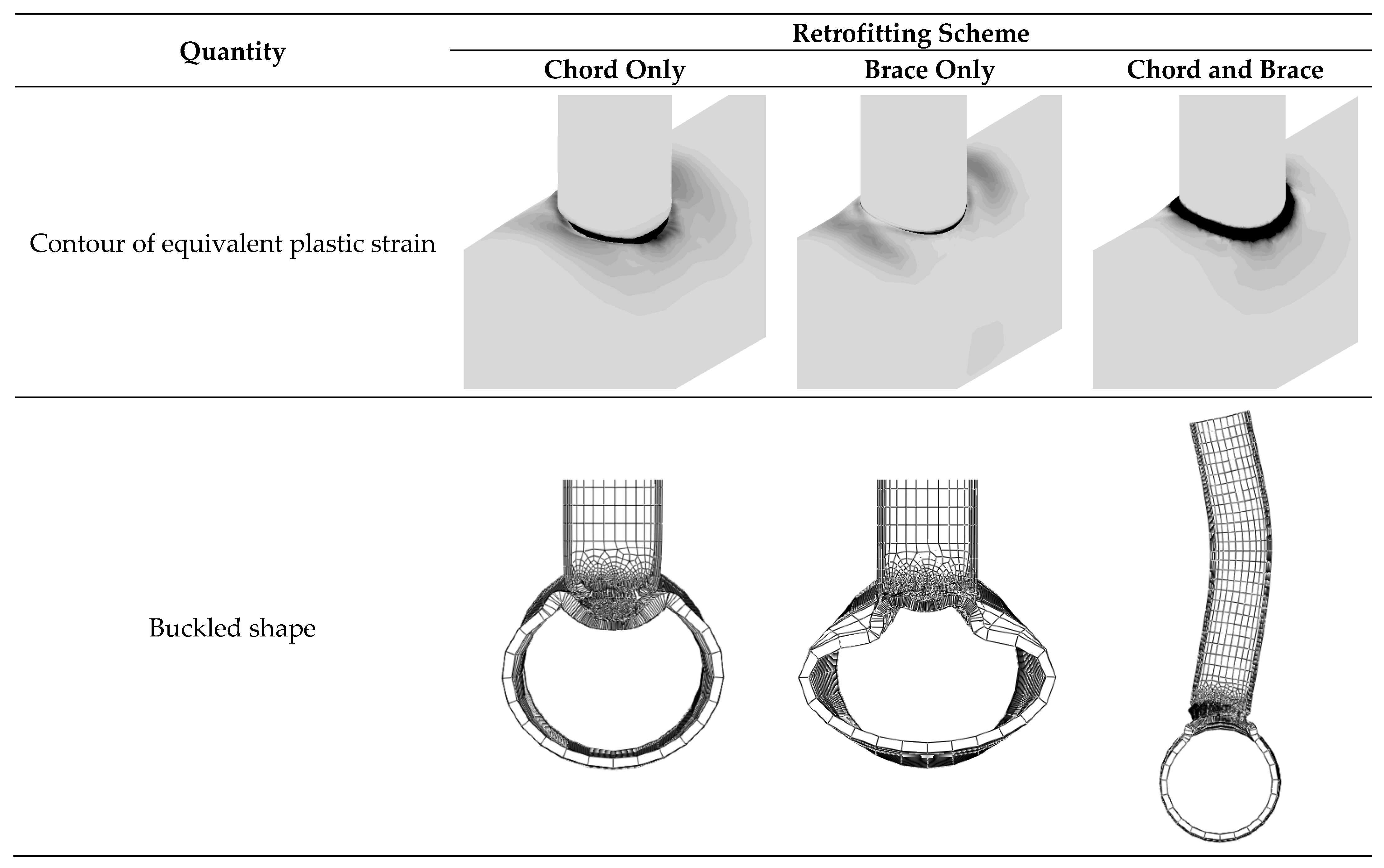
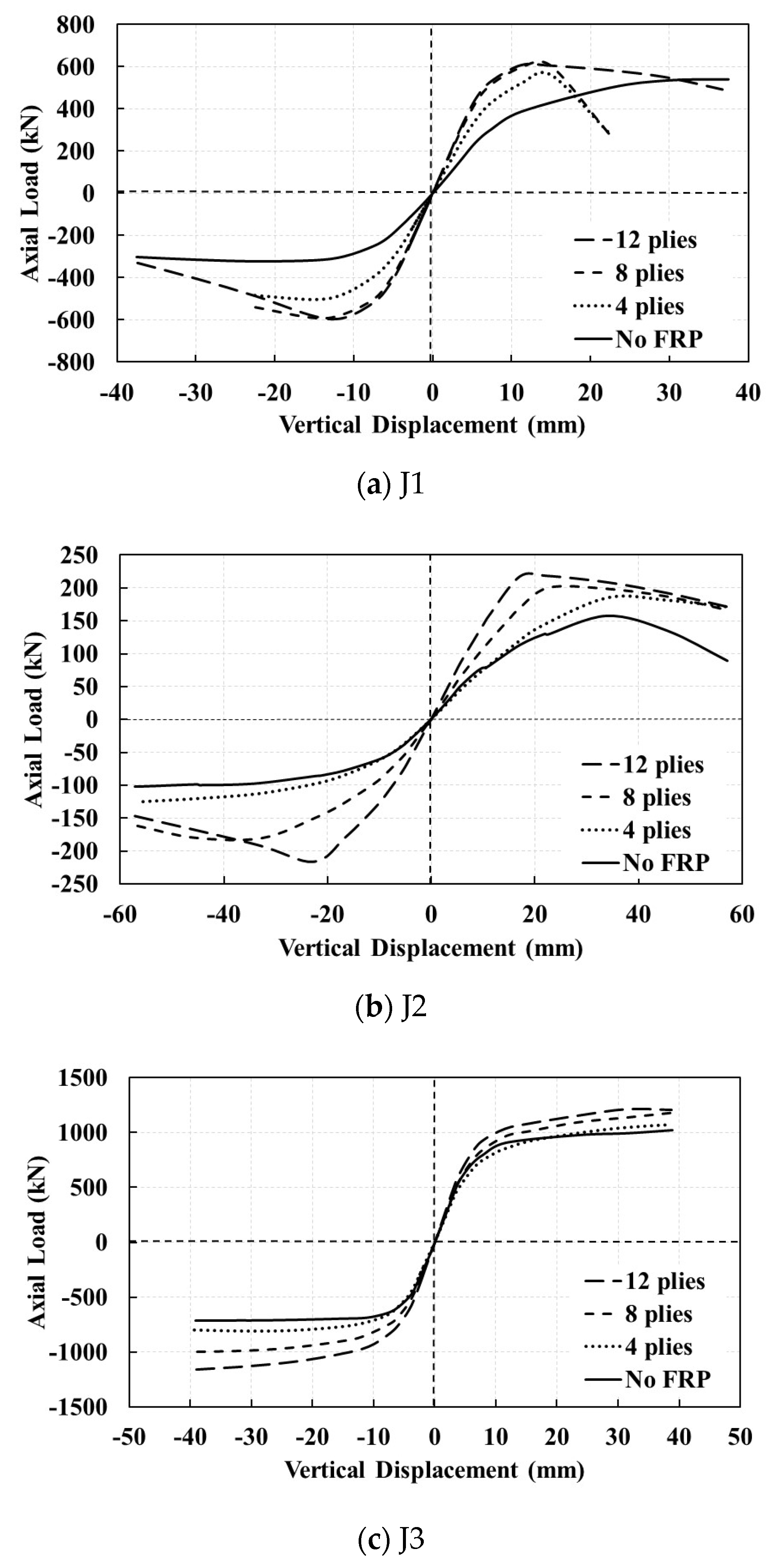
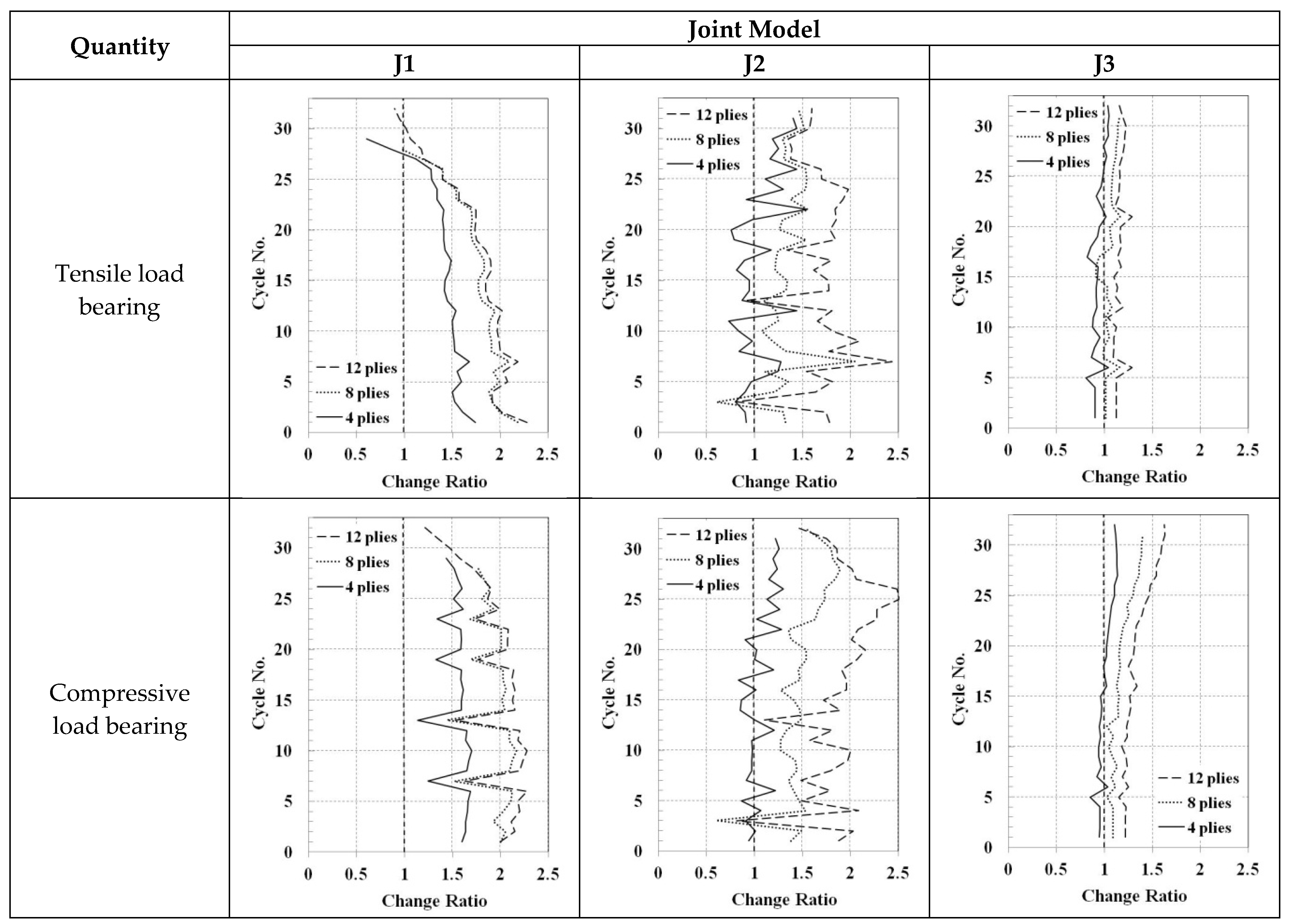

| Joint Name | D (mm) | d (mm) | T (mm) | t (mm) | L (mm) | β | γ |
|---|---|---|---|---|---|---|---|
| J1 | 245 | 121 | 12 | 8 | 1500 | 0.49 | 10.21 |
| J2 | 458 | 165 | 5 | 5 | 2286 | 0.36 | 45.80 |
| J3 | 508 | 406 | 8 | 8 | 1575 | 0.80 | 31.75 |
| Temperature (°C) | Specific Heat (J/g °C) | Conductivity (J/mm °C s) | Density (g/mm3) | Yield Stress (Mpa) | Thermal Expansion Coefficient (°C−1) | Young’s Modulus (GPa) |
|---|---|---|---|---|---|---|
| 0 | 0.462 | 0.015 | 0.790 | 375 | 1.70 × 10−5 | 198.5 |
| 100 | 0.496 | 0.015 | 0.788 | 311 | 1.74 × 10−5 | 193 |
| 200 | 0.512 | 0.016 | 0.783 | 251.14 | 1.80 × 10−5 | 185 |
| 300 | 0.525 | 0.018 | 0.779 | 231.96 | 1.86 × 10−5 | 176 |
| 400 | 0.54 | 0.018 | 0.775 | 212.78 | 1.91 × 10−5 | 167 |
| 600 | 0.577 | 0.021 | 0.766 | 174.42 | 1.96 × 10−5 | 159 |
| 800 | 0.604 | 0.024 | 0.756 | 136.06 | 2.02 × 10−5 | 151 |
| 1200 | 0.676 | 0.032 | 0.737 | 59.34 | 2.07 × 10−5 | 60 |
| 1300 | 0.692 | 0.034 | 0.732 | 40.16 | 2.11 × 10−5 | 20 |
| 1500 | 0.700 | 0.120 | 0.732 | 1.795 | 2.16 × 10−5 | 10 |
| Composite Type | E1 (MPa) | E2 (MPa) | υ12 | G12 (MPa) | G23 (MPa) | G13 (MPa) |
|---|---|---|---|---|---|---|
| Carbon epoxy | 230,000 | 14,816 | 0.17 | 7408 | 7408 | 2963 |
Publisher’s Note: MDPI stays neutral with regard to jurisdictional claims in published maps and institutional affiliations. |
© 2021 by the authors. Licensee MDPI, Basel, Switzerland. This article is an open access article distributed under the terms and conditions of the Creative Commons Attribution (CC BY) license (http://creativecommons.org/licenses/by/4.0/).
Share and Cite
Alembagheri, M.; Rashidi, M.; Yazdi, A.; Samali, B. Numerical Analysis of Axial Cyclic Behavior of FRP Retrofitted CHS Joints. Materials 2021, 14, 648. https://doi.org/10.3390/ma14030648
Alembagheri M, Rashidi M, Yazdi A, Samali B. Numerical Analysis of Axial Cyclic Behavior of FRP Retrofitted CHS Joints. Materials. 2021; 14(3):648. https://doi.org/10.3390/ma14030648
Chicago/Turabian StyleAlembagheri, Mohammad, Maria Rashidi, Amin Yazdi, and Bijan Samali. 2021. "Numerical Analysis of Axial Cyclic Behavior of FRP Retrofitted CHS Joints" Materials 14, no. 3: 648. https://doi.org/10.3390/ma14030648
APA StyleAlembagheri, M., Rashidi, M., Yazdi, A., & Samali, B. (2021). Numerical Analysis of Axial Cyclic Behavior of FRP Retrofitted CHS Joints. Materials, 14(3), 648. https://doi.org/10.3390/ma14030648








